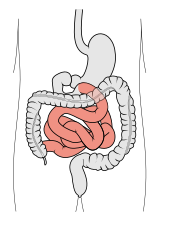Jelito kręte
| Ileum | |
 Przewód pokarmowy, z zaznaczonym jelitem czczym i krętym | |
 Jelito kręte wraz z jelitem ślepym, widoczna zastawka krętniczo-kątnicza | |
| Narządy | |
|---|---|
| Tętnice | Tętnice krętnicze |
| Żyły | Żyły krętnicze |
| Nerwy | Zwoje trzewne, nerw błędny |
| Układ limfatyczny | węzły chłonne przyjelitowe |
Jelito kręte (łac. ileum) – końcowy odcinek jelita cienkiego. U człowieka ma ono około 3 metrów długości. W tej części przewodu pokarmowego zachodzą końcowe etapy trawienia, oraz wchłanianie strawionej treści pokarmowej. Jelito to kończy się zastawką krętniczo-kątniczą[1].
Przypisy
- ↑ R.L. Drake, A.W. Vogl, A.W.M. Mitchell, Gray anatomia. Podręcznik dla studentów. Tom 2, M. Polguj, K.S. Jędrzejewski (red.), Edra Urban & Partner, ISBN 978-83-66548-15-2.
![]() Przeczytaj ostrzeżenie dotyczące informacji medycznych i pokrewnych zamieszczonych w Wikipedii.
Przeczytaj ostrzeżenie dotyczące informacji medycznych i pokrewnych zamieszczonych w Wikipedii.
Media użyte na tej stronie
The Star of Life, medical symbol used on some ambulances.
Star of Life was designed/created by a National Highway Traffic Safety Administration (US Gov) employee and is thus in the public domain.Autor: Olek Remesz (wiki-pl: Orem, commons: Orem), Licencja: CC BY-SA 2.5
Ta ^specifik^ z W3C grafika wektorowa została stworzona za pomocą Inkscape.
Star of life, blue version. Represents the Rod of Asclepius, with a snake around it, on a 6-branch star shaped as the cross of 3 thick 3:1 rectangles.
Design:
The logo is basically unicolor, most often a slate or medium blue, but this design uses a slightly lighter shade of blue for the outer outline of the cross, and the outlines of the rod and of the snake. The background is transparent (but the star includes a small inner plain white outline). This makes this image usable and visible on any background, including blue. The light shade of color for the outlines makes the form more visible at smaller resolutions, so that the image can easily be used as an icon.
This SVG file was manually created to specify alignments, to use only integers at the core 192x192 size, to get smooth curves on connection points (without any angle), to make a perfect logo centered in a exact square, to use a more precise geometry for the star and to use slate blue color with slightly lighter outlines on the cross, the rod and snake.
Finally, the SVG file is clean and contains no unnecessary XML elements or attributes, CSS styles or transforms that are usually added silently by common SVG editors (like Sodipodi or Inkscape) and that just pollute the final document, so it just needs the core SVG elements for the rendering. This is why its file size is so small.



